These appendices are nonmandatory and are included for reference and information purposes only.
Appendix B—Nonmandatory: Life safety ropes. (1) Life safety rope may be significantly weakened by abrasion, misuse, contamination, wear, and stresses approaching its breaking strength, particularly impact loading. Since there are no approved methods to service test a rope without compromising its strength, rope rescue and training operations should be carefully observed and monitored for conditions that could cause immediate failure or result in undetectable damage to the rope.
(2) If a rope has been used in a situation that could not be supervised or where potential damage may have occurred, it must be removed from service and destroyed.
(3) It is important that ropes be inspected for signs of wear by qualified individuals after each use. If indication of wear or damage are noted, or if the rope has been stressed in excess of the manufacturer's recommendation or impact loaded, it must be destroyed.
(4) The destruction of the rope means that it must be removed from service and altered in such a manner that it could not be mistakenly used as a life safety rope. This alteration could include disposing of the rope, or removal of identifying labels and attachments, and cutting the rope into short lengths that could be used for utility purposes.
(5) The assignment of "disposable" life safety ropes to members or to vehicles has proved to be an effective system to manage ropes that are provided for emergency use and are used infrequently. Special rescue teams, which train frequently and use large quantities of rope, should include members who are qualified to manage and evaluate the condition of their ropes and determine the limitations upon their reuse.
Appendix C—Nonmandatory: Decontamination. (1) A decontamination area should be established whenever civilians or fire department personnel have had known or suspected exposure to toxic chemicals.
(2) Such decontamination areas should be established before any personnel are allowed to enter the "Hot" zone.
(3) The decontamination area should be set up using the following guidelines:
(a) The decontamination area should be located uphill, upwind and at a right angle to the "Hot" zone.
(b) The decontamination area entry/exit point and boundaries should be clearly marked using flagging tape, ropes, cones, etc.
(4) 4 to 6 mil poly sheeting should be spread on the ground in the decontamination area to control runoff.
(5) The decontamination process is divided into stations. In most cases it will not be necessary to utilize all the stations. The decision to use all or part of the stations should be based on the following factors:
(a) The hazards associated with the product involved.
(b) The estimated levels of contamination.
(c) The type of protective equipment worn by contaminated responders.
(d) Recommendations from outside sources such as, but not limited to CHEMTREC, the agency for toxic substance and disease registry, poison control centers or the manufacturer of the product.
(6) The following is a list of all the stations in a nine-step decontamination area set up for a worst case scenario involving a hazardous materials response team member whose chemical suit has been breached:
(a) Station #1 - Segregated equipment drop: Contaminated equipment that will be used again in the "Hot" zone, disposed of, or decontaminated at a later time or place, will be deposited here.
(b) Station #2 - Wash/rinse: Entry personnel will be washed with appropriate decontamination solution and rinsed with water by attendant(s) to remove gross contamination. This station may consist of multiple wash/rinse steps depending on the severity of the hazards involved.
(c) Station #3 - Outer protective clothing removal: Attendant(s) will remove the outer protective clothing from entry personnel being cautious to avoid touching the inside of the suit while removing it. Protective clothing that has been removed at this step must be placed in an overpack or other appropriate container for later testing and further decontamination, if needed.
(d) Station #4 - Removal of SCBA: The entry personnel are assisted in removing their SCBA by an attendant. The SCBA facepiece should be left in place and the low pressure hose held away from any potentially contaminated inner clothing.
(e) Station #5 - Removal of inner clothing: All clothing worn inside the suit must be removed in cases where the suit has been penetrated and the entry personnel are contaminated.
(f) Station #6 - Personal shower: Entry personnel should wash and rinse entire body with mild soap and water. Contain runoff water if possible, however this is an emergency situation and containment is secondary to removing contaminants from personnel.
(g) Station #7 - Drying off: Entry personnel that have showered should dry off using towels or whatever is available. Items used should be placed in an appropriate container for disposal. Emergency clothing such as disposable coveralls should be provided.
(h) Station #8 - Medical evaluation: Entry personnel should be evaluated by paramedics - checking vital signs including temperature and level of consciousness. Records of the evaluation must be kept and given to the team safety officer to be included in the members exposure records.
(i) Station #9 - Transport to emergency room: Any personnel exhibiting any signs or symptoms of exposure should be transported to the emergency room for evaluation and observation.
(7) The hazardous materials response team van should carry premeasured packets of decontamination solution mixes for the purpose of decontaminating chemical protective clothing and other equipment at the scene of a hazardous materials emergency. These solutions are not to be used to decontaminate turnouts or exposed skin under any circumstances.
(8) The primary solution used will be a simple detergent and water mixture. Other special decontamination solution mixes will only be used in those situations when it is determined that the detergent and water solution is inappropriate.
(9) Contaminated civilians that are exhibiting signs or symptoms of exposure should be treated as patients. Due to the risk of secondary contamination, all patients should undergo emergency field decontamination at the scene before being evaluated by medical personnel or being transported to the emergency room. Medical personnel should not accept any patient that has not been grossly decontaminated.
(10) The emergency field decontamination process should consist of removing the clothing from all affected body parts of the exposed person and flushing with copious quantities of water from a garden hose or low pressure one and three-quarter inch handline to remove gross contamination. Patients will be flushed for up to fifteen minutes, depending on the material recommendations on patient decontamination.
(11) Members performing patient decontamination should wear, at a minimum, full turnouts and SCBA and should avoid splashes and overspray to the extent possible. They should also undergo decontamination when they have finished decontaminating the patient.
(12) Containment of the runoff water from patient decontamination is not required. Do not delay decontamination of patients to set up containment. However, some form of privacy screen should be erected to protect the modesty of those being decontaminated.
(13) Responders that are contaminated in the process of performing rescue or other tasks will, at the minimum, be flushed with water for a minimum of one minute. Further flushing will be performed depending on the extent of contamination and subsequent adverse health effects.
Appendix D—Nonmandatory:
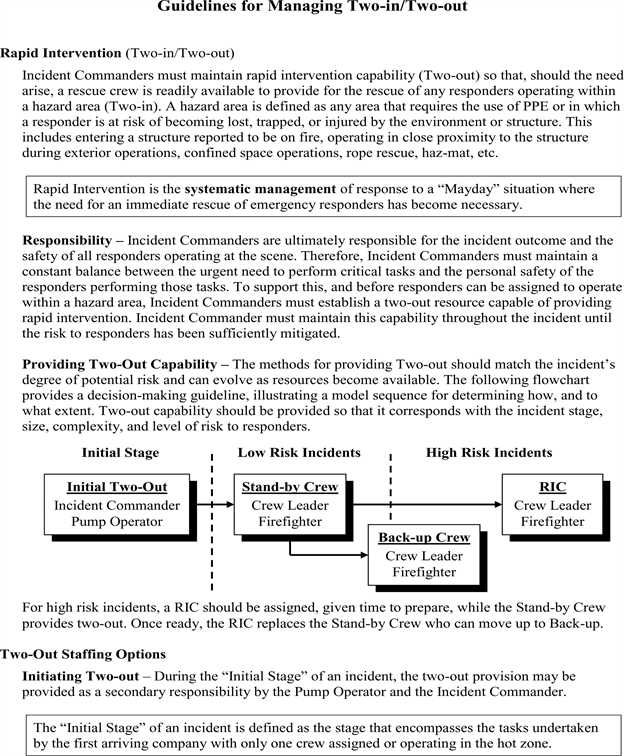 |
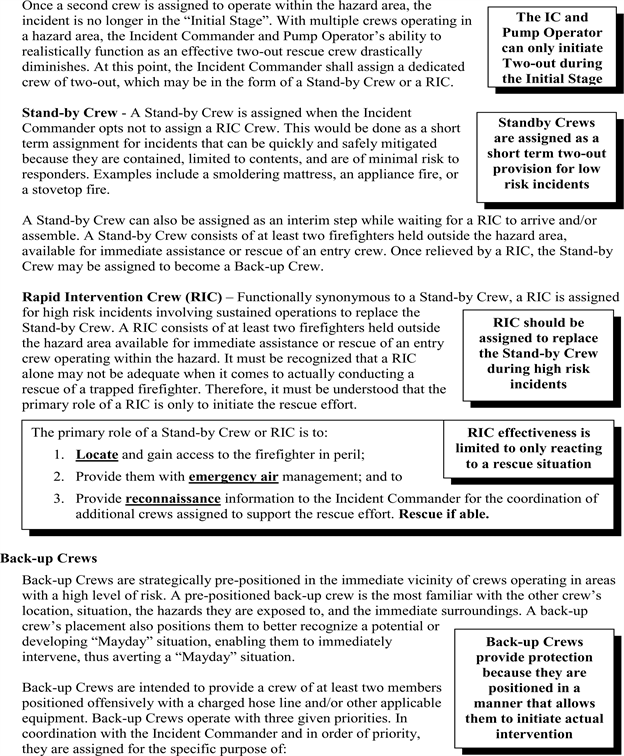 |
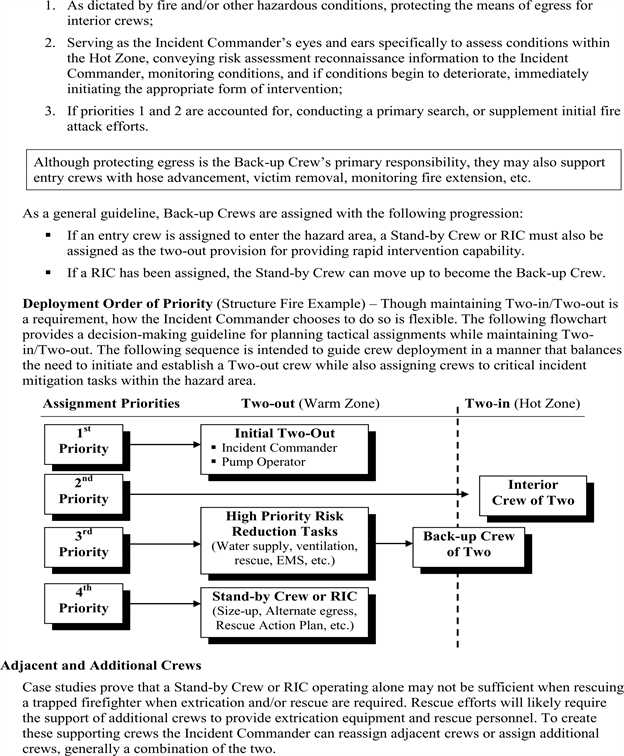 |
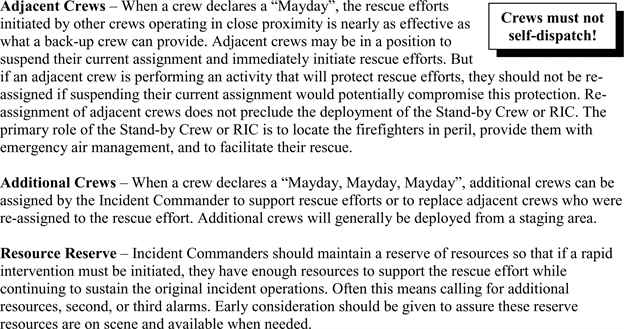 |
Appendix E—Nonmandatory: Standard apparatus operation communications.
When firefighters ride in the tiller's seat or other remote location, an electrical signal or voice communication should be installed between the tiller's seat, work station, and driver's compartment.
(1) These signals should be used between the driver and the firefighters:
(a) One long buzz means stop;
(b) Two buzzes mean forward;
(c) Three buzzes mean reverse.
(2) Before any of the above functions are undertaken, with the exception of stopping, the same signal must be both sent and received. The driver should not act without sending and receiving a confirming signal.
(3) When using hand signals, these signals are as follows:
STOP
Hold hand to the side, shoulder high, exposing palm to the driver. At night, hold hands in the same manner, with the addition of a flashlight in one hand shining at the driver. This will indicate an immediate STOP.
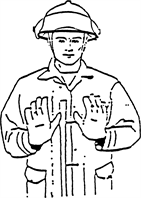 |
STOP |
Hold hand to the side, shoulder high, exposing palm to the driver. At night, hold hands in the same manner, with the addition of a flashlight in one hand shining at the driver. This will indicate an immediate STOP.
RIGHT OR LEFT
Point in the desired direction with one hand and motion in a circular "come-on" gesture with the other hand at the chest level. At night direct a flashlight beam at the hand pointing in the desired direction.
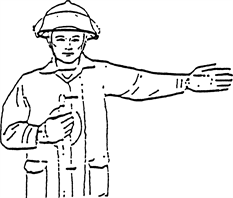 |
RIGHT OR LEFT |
Point in the desired direction with one hand and motion in a circular "come-on" gesture with other at the chest level. At night, direct a flashlight beam at the hand pointing in the desired direction.
DIMINISHING CLEARANCE
Hold the hands to one side of the body indicating the approximate amount of distance the apparatus is from the obstacle. Close hands accordingly as the driver slowly maneuvers the apparatus to point where the signal indicates immediate STOP. Always allow enough for drivers reaction time.
At night, indicate in the same manner with the flashlight in the upper hands and beam directed at the palm of the other. On STOP, cover the flashlight beam with the hands.
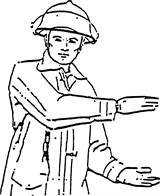 |
DIMINISHING CLEARANCE |
Hold the hands to one side of the body indicating the approximate amount of distance the apparatus is from the obstacle. Close hands accordingly as the driver slowly maneuvers the apparatus to point where the signal indicates immediate STOP. Always allow enough for divers reaction time. At night, indicate in the same manner with the flashlight in the upper hands and beam directed at the palm of the other. On STOP, cover the flashlight beam with the hands.
AHEAD OR BACK UP
Hold hand directly in front, chest high, fingers on hands directed toward one another, and motion in a circular "come-on" gesture. At night hold a flashlight in one hand and direct the beam toward the other.
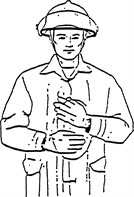 |
AHEAD OR BACK UP |
Hold hand directly in front, chest high, fingers on hands directed toward one another, and motion in circular "come-on" gesture. At night hold a flashlight in one hand and direct the beam toward the other.